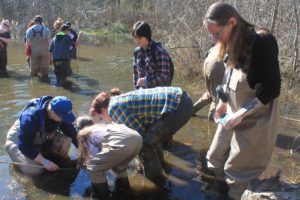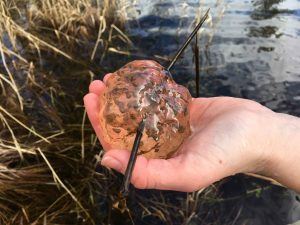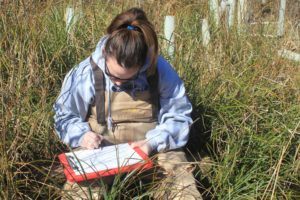On a clear spring day at Northwest Trek, Amy Newton is standing hip-deep in a chilly pond. Waterproof notebook and GPS in hand, she peers into the cloudy water.
“Guys! We need your help over here – I think it’s a Pacific tree frog!” she calls.
With the moon-walk gait of people who don’t want to squish anything, John Miller and Kim Bryant wade over and inspect.
“Yeah, I think so,” pronounces Miller.
“So cool,” adds Bryant, gently fingering the sloppy, Jello-like mass in the water.
It’s Amphibian Egg Mass training day at Northwest Trek, and Miller, Newton and Bryant – college grads and students – are three of 26 volunteers who’ve signed up this year to learn how to spot amphibian eggs.

Counting to protect
Why? Well, apart from the fun of wading through wetlands, they’re collecting important data on local frogs, toads, newts and salamanders that help agencies better protect and conserve them for the future.
“I’ve done wetland restoration before, and it’s so beautiful here,” explains Bryant, a marine ecology student.
Miller, meanwhile, has collected egg mass data before in Eastern Washington, and as a recent graduate in wildlife ecology he’s keen to learn about species around here.
As he points out a hopping Pacific tree frog, everyone coos in admiration for the tiny amphibian.
“Not so many people are doing this actively, so it’s good to help out,” adds Bryant.
Monitoring amphibian egg masses – and training others to do it – is something Northwest Trek has been doing since 2011. Most of the action happens outside the public area of the wildlife park, in a mitigation site that staff have spent the last six years restoring back to its original wetland condition.
“Amphibians are an indicator species – their presence or absence can show the health of that area.” – Rachael Mueller
“Amphibians are an indicator species – their presence or absence can show the health of that area,” says Rachael Mueller, Trek’s Conservation Program Coordinator. “Monitoring vulnerable species can help decision-makers make informed management decisions.”
And the Trek mitigation area, says Mueller, is ideal for this monitoring – since its restoration, eggs have been seen from seven of the eight species of stillwater-breeding amphibians monitored by the wildlife park.
But basically, it’s fun
Mueller’s enthusiasm for amphibians is contagious. Right now she’s bending over the edge of another pond, calling volunteers around her and pointing to a globular mass.

“Look – you can tell, see how spread out the eggs are?” she says excitedly. “That’s a long-toed salamander egg mass!”
Encouraged, Bryant points. “See, there’s another one.”
“Cool!” Mueller exclaims. “And see how the eggs are all packed into that one there? That’s a tree frog mass. As they develop they become lighter, while the long-toeds get darker. They only just started breeding out here.”
Volunteers to hunt amphibian eggs come in all shapes and sizes. Some are students; others retirees. There are several young kids, staring wide-eyed at the slithery, jelly-ish masses attached to reeds and grasses just under the surface of what looks like an ordinary pond.
“Now, here’s a Northwest salamander mass,” continues Mueller, holding up a clear, grapefruit-sized globule with tiny black dots inside. “I want you guys to touch it, feel the weight of it. That’s unique to that egg mass. And look, here’s a red-legged frog mass – it’s really sloppy. You couldn’t pick that up if you tried, it would just slither through your fingers.”
“Oh wow. Oh man,” says one volunteer in awe. “That’s crazy.”
But the youngest volunteer has another word for it.
“Ewwwww!” she cries, fascinated.

Learning to ID eggs
All volunteers go through a classroom training to learn key differences in the egg masses they’ll encounter both at Trek and in their home wetlands. Color is usually not a reliable indicator; instead, Mueller has them look for texture, size, weight, egg density and placement in the water.
They’re taught how to carefully handle egg masses – something done only for survey training and data purposes under expert supervision, with the right government permits.
Each volunteer is also loaned a data notepad, GPS (for recording accurate location) and waders.
And some of them might come to Mueller’s other spring citizen science opportunity: learning to identify adult frogs and toads by their breeding call as part of FrogWatch USA.
Finally, everyone troops back through the undergrowth to change back into street shoes and compare notes.
While it might seem like a fun morning of wading, amphibian egg mass monitoring could be a matter of life or death for some species. The Oregon spotted frog is endangered in Washington, and threatened U.S.-wide. It’s the only species so far not spotted at Northwest Trek.
“It is vital to the survival of that frog to locate and protect its breeding areas,” points out Mueller.
But monitoring is good for volunteers, too.
“It’s an engaging experience that lets volunteers connect with and appreciate nature,” Mueller says, “and contribute to local conservation. Wildlife agencies have more land than they have staff, and volunteers play a critical monitoring role.”